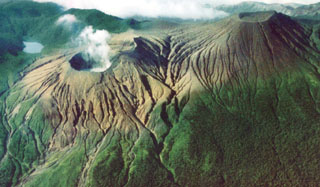Report on Rincon de la Vieja (Costa Rica) — August 2019
Bulletin of the Global Volcanism Network, vol. 44, no. 8 (August 2019)
Managing Editor: Edward Venzke.
Research and preparation by Paul Berger.
Rincon de la Vieja (Costa Rica) Occasional weak phreatic explosions during March-July 2019
Please cite this report as:
Global Volcanism Program, 2019. Report on Rincon de la Vieja (Costa Rica) (Venzke, E., ed.). Bulletin of the Global Volcanism Network, 44:8. Smithsonian Institution. https://doi.org/10.5479/si.GVP.BGVN201908-345020
Rincon de la Vieja
Costa Rica
10.83°N, 85.324°W; summit elev. 1916 m
All times are local (unless otherwise noted)
The acid lake of Rincón de la Vieja's active crater has generated intermittent weak phreatic explosions regularly since 2011, continuing during the past year through at least August 2019. The volcano is monitored by the Observatorio Vulcanologico Sismologica de Costa Rica-Universidad Nacional (OVSICORI-UNA), and the information below comes from its weekly bulletins between 4 March and 2 September 2019. Clouds often prevented webcam and satellite views. The current report describes activity from March through July 2019.
OVSICORI-UNA reported that weak events occurred on 19 March at 1851 and on 29 March 2019 at 2043. A two-minute-long phreatic explosion on 1 April at 0802 produced a plume that rose 600 m above the crater rim. Continuous emissions were visible during 3-4 April, rising 200 m above the crater rim. On 3 April, at 1437, a small explosion was detected. An explosion on 10 April at 0617 produced a gas-and-steam plume that rose 1 km above the crater rim and drifted SE. On 12 April at 0643, a plume rose 500 m. Another event took place at 0700 on 13 April, although poor weather conditions prevented visual observations. On 14 April, OVSICORI-UNA noted that aerial photographs showed a milky-gray acid lake at a relatively low water level with convection cells of several tens meters of diameter in the center and eastern parts of the lake.
According to an OVSICORI-UNA bulletin, a small phreatic explosion occurred on 1 May. Another explosion on 11 May at 0720 produced a white gas-and-steam plume that rose 600 m above the crater rim. Phreatic explosions were recorded on 14 May at 1703 and on 17 May at 0357, though dense fog prevented visual confirmation of both events with webcams. On 15 May a local observer noted a diffuse plume of steam and gas, material rising from the crater, and photographed milky-gray deposits on the N part of the crater rim ejected from the event the day before. A major explosion occurred on 24 May.
OVSICORI-UNA recorded a significant phreatic 10-minute-long explosion that began on 11 June at 0343, but plumes were not visible due to weather conditions. No further phreatic events were reported in July.
Seismic activity was very low during the reporting period, and there was no significant deformation. Short tremors were frequent toward the end of April, but were only periodic in May and June; tremor almost disappeared in July. A few long-period earthquakes were recorded, and volcano-tectonic earthquakes were even less frequent.
Geological Summary. Rincón de la Vieja, the largest volcano in NW Costa Rica, is a remote volcanic complex in the Guanacaste Range. The volcano consists of an elongated, arcuate NW-SE-trending ridge constructed within the 15-km-wide early Pleistocene Guachipelín caldera, whose rim is exposed on the south side. Sometimes known as the "Colossus of Guanacaste," it has an estimated volume of 130 km3 and contains at least nine major eruptive centers. Activity has migrated to the SE, where the youngest-looking craters are located. The twin cone of Santa María volcano, the highest peak of the complex, is located at the eastern end of a smaller, 5-km-wide caldera and has a 500-m-wide crater. A Plinian eruption producing the 0.25 km3 Río Blanca tephra about 3,500 years ago was the last major magmatic eruption. All subsequent eruptions, including numerous historical eruptions possibly dating back to the 16th century, have been from the prominent active crater containing a 500-m-wide acid lake located ENE of Von Seebach crater.
Information Contacts: Observatorio Vulcanologico Sismologica de Costa Rica-Universidad Nacional (OVSICORI-UNA), Apartado 86-3000, Heredia, Costa Rica (URL: http://www.ovsicori.una.ac.cr/, https://www.facebook.com/OVSICORI/).

